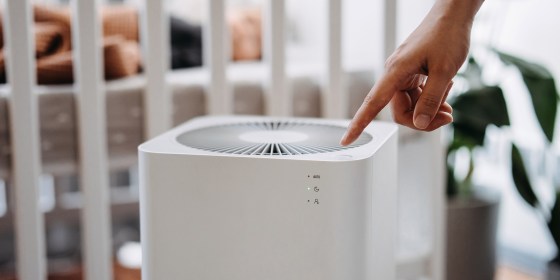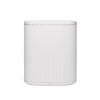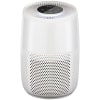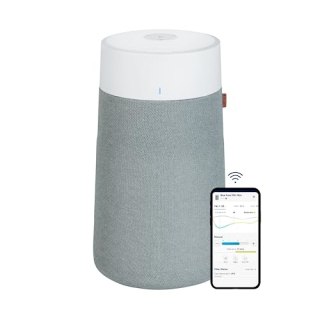According to the Environmental Protection Agency, the air inside your home may be more polluted than the air outdoors, even if you live in a large city center. One way to improve your air quality indoors is by using an air purifier — they can filter air contaminants like dust, pollen and smoke.
NBC Select staffers have used air purifiers for years to filter dust, pet dander, wildfire smoke and more. That’s why we spoke with filtration experts — to better understand air quality, and learn everything you need to know to buy the best air purifier.
SKIP AHEAD The best air purifiers in 2025 | How to shop for an air purifier | Why trust NBC Select?
How we picked the best air purifiers
We spoke with filtration experts to understand the importance of air quality and purification methods. Using their guidance and our experience using air purifiers, we picked models based on the following criteria:
- Filtration: All of our recommendations have high-efficiency particulate air filtration (HEPA) and have a clean air delivery rate (CADR) equivalent of at least two-thirds the recommended room size. (You can learn more about HEPA and CADR in our FAQ section.)
- Independent testing: We only picked air purifiers independently tested by the Association of Home Appliance Manufacturers (AHAM), which certifies the performance of air purifiers through its AHAM Verifide program.
- Adjustability: We only picked air purifiers with at least three adjustable speed levels. Air purifiers can be loud at their highest speed — having a lower speed option is crucial for keeping spaces like bedrooms quiet, in our experience.
Want more from NBC Select? Sign up for our newsletter, The Selection, and shop smarter.
The best lab-certified air purifiers in 2025
Most of our recommendations are either staff favorites or top-rated products from large brands like Blueair and Honeywell. Below each recommendation we share specifications we think you should know like recommended room size according to AHAM and decibel levels.
Editor’s Pick: Windmill Air Purifier
- Attractive design
- Robust app controls
- Button controls on the unit
- Heavy
Multiple NBC Select staffers use and love this robust and stylish air purifier from Windmill. NBC Select reporter Zoe Malin has a severe seasonal and dust allergy, but has had fewer symptoms ever since she put this purifier in her bedroom. Similarly, NBC Select associate reporter Bianca Alvarez lives with a partner who has asthma and he noticed his breathing ease after living with this purifier.
Both Malin and Alvarez use the Windmill Air app to control the unit remotely from their phones — the app lets you easily check your air quality, filter status and set up automated schedules and routines.
The Windmill Air Purifier has another great feature — the child lock function — Malin uses it to prevent her cats from accidentally changing the settings when they inevitably jump on top of the unit. It comes in multiple colors but do note that it is heavy at 21 pounds.
Recommended room size (AHAM): 442 sq. ft. | Decibels: 16 — 54 dB | CADR (CFM): smoke: 286, dust: 284, pollen: 343 | Connectivity: yes, Windmill Air app | Speeds: 5 | Weight: 21 lbs | AHAM verified: yes
For small spaces: Instant AP 100
- Small and portable
- Smart auto mode
- Low CADR
Malin used this more compact air purifier for years before replacing it with a larger one. Her favorite thing about it is that it’s totally hands-off — it senses the air quality in your room and adjusts settings accordingly, says Malin. This auto mode feature is rare in air purifiers at this price range.
Another standout feature is the light sensor. When Malin turned off the lights in her apartment, the air purifier automatically dimmed its display lights and reduced its speed to its quietest setting, which is about as loud as a bedroom fan, says Malin.
This air purifier is best for smaller bedrooms and offices no larger than 126 square feet, according to AHAM.
Recommended room size (AHAM): 126 sq. ft. | Decibels: 24 — 50 dB | CADR (CFM): smoke: 81, dust: 85, pollen: 98 | Connectivity: no | Speeds: 3 | Weight: 8 lbs | AHAM verified: yes
For large spaces: Blueair Pure 311i+ Max
- Great filtration
- Fabric pre-filter
- Smart connectivity
- Nothing to note at this time
I received the Blue Pure 311i+ Max from the brand and have been using it in my large bedroom for years, including during 2023’s Canadian wildfire season. On the day of some of the worst air pollution in NYC, the NBC Select office smelled like a BBQ while my apartment, which had this air purifier running, smelled completely normal. During the spring allergy season, I usually wake up with a stuffy nose, sneezing. With this air purifier, I rarely had either symptom.
It pulls unfiltered air from all directions into its base — I have mine near the corner of my bedroom. I usually keep it on speed one or night mode — it only adds one or two decibels to the general ambience of my bedroom, increasing noise from 32 dB to 34 dB (according to a decibel reader on my phone).
You can control it manually or with the Blueair app, where you can see detailed stats like indoor air quality and filter status. I use the app to set a schedule for the purifier — it automatically changes to night mode, the lowest and quietest speed, every evening around 9 PM.
Recommended room size (AHAM): 465 sq. ft. | Decibels: 23 — 50 dB | CADR (CFM): smoke: 300, dust: 300, pollen: 300 | Connectivity: yes, Blueair app | Speeds: 4 | Weight: 7.9 lbs | AHAM verified: yes
For powerful performance: Honeywell HPA304
- High CADR
- Large room size
- Large and heavy
This air purifier is a good fit if you need strong filtration for a large space. According to AHAM lab results, it has a very high CADR (especially for its price), meaning it can filter out air contaminants quickly and effectively. Plus it has a 4.6-star average rating from over 32,000 reviews on Amazon.
It has four speed modes: low, medium, high and turbo. If you plan to put this in a bedroom, use the dimmer button to turn off the panel lights on top of the purifier. It also has a timer button for intervals of two, four and eight hours.
Unlike the Blueair Pure 311+ Max, this purifier does not have an auto mode, a companion app or a night mode.
Recommended room size (AHAM): 465 sq. ft. | Decibels: undisclosed | CADR (CFM): smoke: 300, dust: 320, pollen: 300 | Connectivity: no | Speeds: 4 | Weight: 17 lbs | AHAM verified: yes
How to shop for an air purifier
Air purifiers are designed to remove indoor air pollution caused by fuel-burning appliances, cleaning products, heating and cooling systems, car pollution, wildfire smoke and everything in between. These indoor contaminants can enter your lungs and cause irritation or trigger allergic reactions, says Kenneth Mendez, president of the nonprofit Asthma and Allergy Foundation of America.
Filtration is key when choosing an air purifier. Our experts highlight two factors in getting effective filtration: HEPA filters and an appropriate CADR. You can read more about both in the following FAQ section.
Meet our experts
At NBC Select, we work with experts who have specialized knowledge and authority based on relevant training and/or experience. We also take steps to ensure all expert advice and recommendations are made independently and without undisclosed financial conflicts of interest.
- Kenneth Mendez is the president of the nonprofit Asthma and Allergy Foundation of America.
- Michael Corbat is the vice president of engineering for Rensa Filtration and former president of the National Air Filtration Association.
Why trust NBC Select?
I am reporter at NBC Select who covers technology including guides to smartwatches, portable air conditioners, and over-ear headphones. For this piece, I spoke with filtration experts to better understand air purifiers and how they function. I leveraged NBC Select staff and personal experience using air purifiers to recommend the best ones certified by AHAM.
Catch up on NBC Select’s in-depth coverage of tech and tools, wellness and more, and follow us on Facebook, Instagram, Twitter and TikTok to stay up to date.










